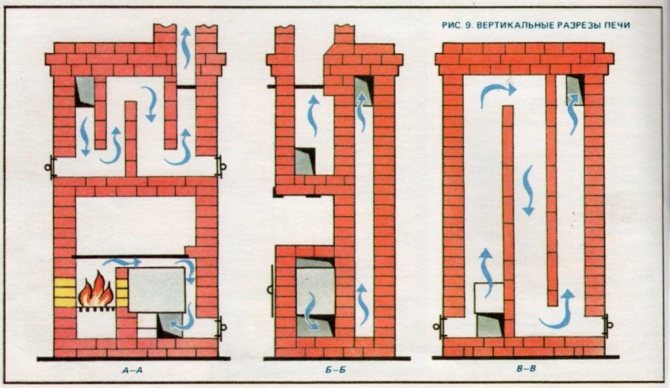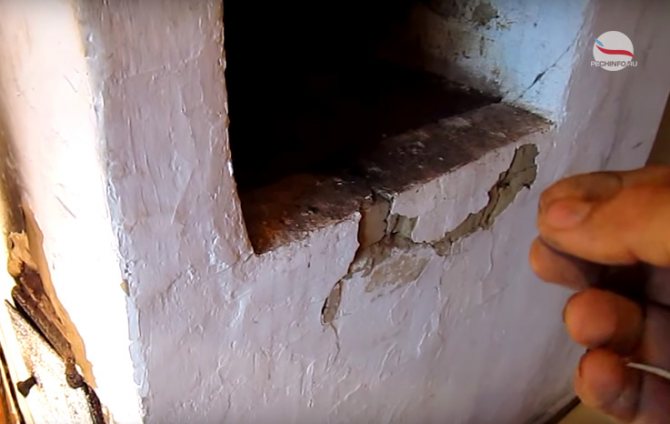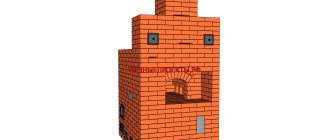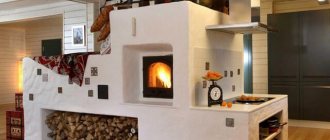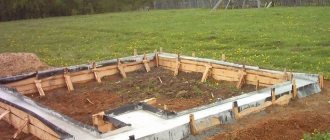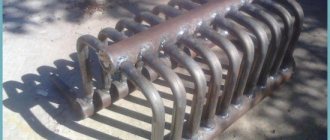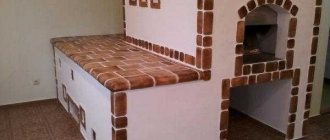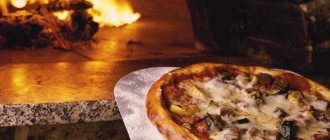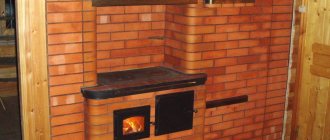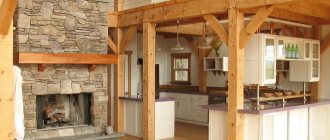Options for converting the stove into a fireplace
How is a fireplace made from a stove? There are several options here, much depends on the initial state of the structure. The simplest option for making a fireplace out of an old stove is that you just need to update the firebox, expand it a little to an acceptable size, and then put a special glass door, which is also called Finnish.
This option is the simplest, there is no need to make changes to the design, it remains the same, but the oven itself must be cleaned. The new door will make the structure as similar to the fireplace as possible, and if you also make decorative cladding, for example, using tiles or marble tiles, then the similarity with the fireplace will be maximum.
The scheme of the brick oven.
There are other options on how to make a fireplace from a conventional stove. The most expensive and difficult part is disassembling the old structure and assembling a new one. First, the furnace is dismantled, after which it is required to inspect the base, it may be necessary to add new sand. After that, a layer of waterproofing from roofing felt is laid on the surface, a new masonry is made according to the selected scheme.
The work process in this case looks like this:
- The old furnace is dismantled, the base is inspected for damage.
- The podium is masonry, which is necessary to protect the base from high temperatures when burning firewood.
- According to the prepared scheme, the laying of the fireplace is performed, which is no different from the usual one. For this, special furnace and refractory bricks are used. The firebox itself can have different sizes, it is recommended to install a glass door, which will not only increase heat transfer, but also make the use of the fireplace safer. The floor around such a structure must be laid out with a refractory material, such as ceramic or stone tiles. The surface of the fireplace is decorated with different finishing materials, of the most stylish it is necessary to note the tiled tiles, which are ideal for any interior.
Buying an old country house, the new owners discover an old stove that has not been used for its intended purpose for quite a long time.
The time has long passed when in every country house a traditional stove was necessarily provided, serving people both as a way of keeping warm in cold winter times, and as a place for preparing food.
The widespread gasification has led to the fact that instead of stoves, fireplaces acquire special relevance, which can also be useful in everyday life, but almost always perform an exclusively decorative function. A fireplace placed in any room of the house creates a really cozy atmosphere.
A fireplace is a rather time-consuming and costly element, therefore, when planning and creating it, it is worth contacting really experienced masters of their craft. The version of the electronic fireplace is also popular, which lives up to its name only visually, but at the same time being inferior to the genuine fireplace in all respects.
A well-worn stove is an excellent basis for constructing a real fireplace. The first step is to visually assess its condition, while the main work on turning it into a fireplace will most often consist in expanding the firebox, updating the chimney pipe, installing the door and other relevant attributes.
Where to begin?
- You should carefully check the condition of the old stove, the level of deterioration of the chimney, and this step is the most important for everyone who lives in the house.A chimney with good maneuverability and confident draft is something without which the fireplace will not function.
It is important to check that the cross-section is not less than the size of at least one brick, otherwise the thrust will not be enough. A chimney with insufficient draft is dismantled in order to replace it with a new one, suitable in all respects. - As a rule, the area of the furnace is very small, which is not suitable for a fireplace.
Accordingly, the right decision would be to increase the firebox during reconstruction. You can also equip the fireplace with a glass door that covers the firebox so that ash and sparks do not fall on foreign objects in the room - this optional element serves as an excellent decorative element. - The body of the furnace structure must also be inspected for large cracks, falling out brick elements and other deformations. Even if no visible damage is visible, it is worth updating the surface in order to make it sophisticated and attractive.
Undoubtedly, a lot depends on the initial state of the existing structure.
First option. The easiest way is to update and expand the firebox, install a glass (Finnish) door. With this option, there is no need to make significant changes to the structure of the existing oven, but it is worth cleaning it. Decorative cladding with wrought iron elements or tiles will give the stove an absolute resemblance to a fireplace.
When operating a ready-made fireplace, it is important to remember that only dry firewood and logs are used for the firebox, coal is not used for this purpose.
Second option. The most difficult and expensive method, as it involves a complete disassembly of the old structure with the subsequent assembly of the updated one. Initially, the elements of the furnace are dismantled, then the base is inspected for the need for additional sand filling.
Next, a waterproofing material is laid, and only after that a new masonry follows, identical to any other, but refractory brick is used at the same time - it is specially made for such purposes. A floor that is resistant to firepower is a must when installing a fireplace.
Tiles are perfect for this role, tiles look good as a decorating material, but in general, the decor depends on the imagination of the owners.
The old stove, once used for household purposes, was traditionally installed in a large central room and did not take up too much space. However, the appearance of the stove structure did not always evoke aesthetic satisfaction. All the more willingly, new owners will want to use an unnecessary relic of the past as an excellent addition to the new interior.
Thus, for all repair actions to convert the stove into a fireplace, you should stock up on the necessary tools, fixtures and materials, which include:
- refractory kiln bricks, the amount of which depends on the amount of work. Finding it is not difficult: the easiest way is to visit the nearest construction market or a construction supermarket;
- cement mortar;
- level;
- clay for mortar;
- Master OK;
- Bulgarian;
- chimney (in case the old one is in an unsatisfactory condition and needs to be replaced);
- facing tiles;
- fireplace door.
To simplify and visualize the desired result, a drawing of the desired fireplace should be prepared in advance, the external design of which is largely determined by the initial state of the stove. An examination of the existing furnace is carried out to find out its reliability, the durability of the existing body, the condition of the foundation.
There is an opinion that earlier, in the Soviet era, everything was done much better, "for centuries" - of course, this opinion is not unfounded, but you should not rely on it too literally: after all, time takes its toll.
Therefore, it is better to make sure of the correctness several times than to soon engage in alteration of a new, but already damaged fireplace.
The depth of the firebox should be 50 centimeters, and the inner body of the fireplace is always laid out with refractory bricks.
If all the necessary conditions are met, the transition to the inspection of the existing chimney is carried out, because it will almost certainly need to be rebuilt.
The requirements for chimneys for stoves and fireplaces are somewhat different: the chimney of a fireplace needs seven meters in height, a cross-section of at least 13 * 25 centimeters. Further, it is necessary to provide for the presence of specialized channels necessary for the presence inside the entire structure in order to control the air flows passing along the doors.
Thanks to this method, soot will not constantly and abundantly accumulate on the glass of the fireplace door.
As stated earlier, the conversion process will not cause difficulties if you responsibly approached the stage of checking the old design and found that it was reliable enough. In this case, they are limited to expanding the opening of the firebox to give it convenience and beauty. Then a glass fireplace door is installed, which has a protective and decorative function.
Thus, after the completion of all major repairs, they begin to finish the existing fireplace.
It is important to use a heat-resistant and reliable material so that it does not get damaged or deformed under high heat loads, and also does not provoke a fire attempt.
We invite you to familiarize yourself with the Tobacco mosaic virus was discovered
Natural or decorated stone, which gives sophistication and presentability to the appearance of the fireplace, is an excellent solution for such purposes. Ordinary heat-resistant brick is also quite popular - it would seem that it is a completely unpretentious material.
Fulfilling a childhood dream of your own fabulous fireplace is not as difficult as it might seem. Nowadays, no one will find it difficult to buy a house in the countryside and equip it as a quiet place to relax from the bustle of the city. And the quiet sound of logs peacefully crackling in the fireplace will surely give you pacification, peace and comfort - something that is really lacking.
How to disassemble a brick oven?

Dismantling the oven begins with a careful inspection. It is necessary to make sure that the device is not at the same time a support for the flow overlap. You also need to provide temporary zones for storing bricks: in the attic, in the residential part and outside the building.
It is advisable to analyze the structure on a sunny summer day, since a hole is formed in the roof after removing the pipe. And working on a slippery surface from rain is quite risky.
Dismantling a pipe depends on the material from which it is made. The easiest way is to remove the metal item, as it is light enough.
The pipe is loosened, removed from the masonry, and then gently wound into the attic.
Advice
The brick structure will need to be disassembled into its constituent elements. Each brick is knocked out of its place using a perforator equipped with a sharpened nozzle. The electric tool can be replaced with a chisel and hammer. True, work with them is progressing more slowly. You have to make more physical efforts.
The dismantling speed also depends on the bonding material between the bricks. The clay solution crumbles quite easily. It is more difficult to break masonry on a cement-sand mixture, since over the years it practically does not lose its strength.
Barbecue complexes are most often placed on such a solution, and for which, when parsing, a brick from a barbecue is no longer suitable for re-laying.
After the pipe, the kana is disassembled.A common mistake at this stage is to store a large number of bricks on the ceiling.
Do not overload the wooden flooring with excess weight. Move the accumulated stones into the living space in a timely manner.
The central part of the oven is removed in a similar manner. You can speed up the work by using a sledgehammer or crowbar. Strong blows break the masonry into separate pieces, which are then stored outside the room.
The foundation of the structure is often not dismantled.
Also, the foundation is dismantled in order to save building material - old bricks are used for various household needs.
Furnace repair: A - replacement of cracked or burnt bricks; B - piping of the cracked furnace.
Trying to save money, many owners of brick ovens are trying to cope with the problem of repairing them on their own. But you need to understand that there are differences between repairs and repairs. Repair of brick ovens is divided into three types: current, partial and major.
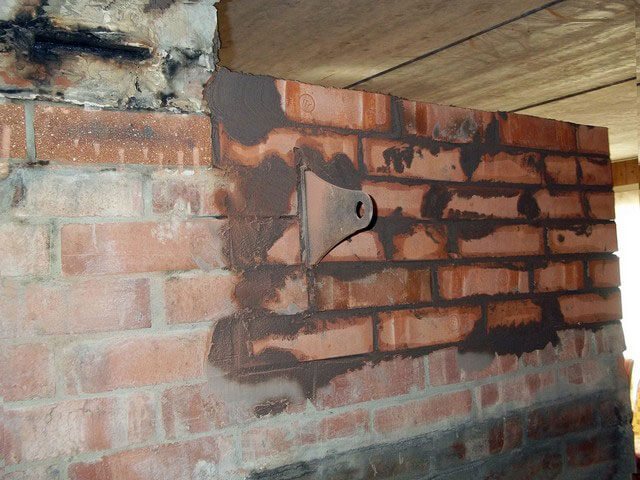

The simplest type of repair is in-line. It consists in maintaining the oven used in a private house or in the country, clean and tidy. The entire repair consists of getting rid of ash and soot from the stove and eliminating minor defects in the brickwork of a brick stove: small cracks, chips. This type of repair is handled by each owner and does not require the presence of a master stove-maker.
Diagram of the device of a bath brick oven.
Partial repair of the furnace involves the replacement of one or more of its parts. It all depends on where these parts are located. Replacing a malfunctioning grate or cast iron plate will not cause any particular difficulties.
And not everyone can replace or strengthen the firebox door or damper.
With such a repair, you need to have at least minimal skills as a bricklayer, since you will have to disassemble and re-fold the brickwork around the damaged part.
note
Also, partial repairs include partial replacement of the firebox lining, partial restoration of chimneys, partial repair of the beginning of the fire channel, etc. With such a repair, having the experience of a bricklayer and carefully examining the masonry of the damaged areas, you can also try to cope on your own. But the chances that you will get it right are not very high.
Overhaul is the most difficult type of repair, and it cannot be done without the help of an experienced stove-maker. The need for such repair arises when partial or complete disassembly of the furnace is required, for example, when upgrading the furnace or rebuilding it for a different type of fuel.
The first thing that causes the need to repair the stove is poor draft, as a result of which the stove begins to smoke heavily. The most likely cause of poor draft is soot deposits in the chimney and chimney. A soot layer of only 3 mm reduces the heat output of the oven by almost half.
A thick layer of soot not only inevitably leads to an almost double overconsumption of fuel, but also significantly increases the risk of fire. Therefore, the passages in the chimney through which the smoke is removed and the chimney must be systematically cleaned of soot.
For this, a long pole is usually used with a brush attached to the end or a large rag wound and tied. You can also use thick wire instead of a pole.
Diagram of the device of the Russian stove.
In this case, the passing gases are rapidly cooled, significantly reducing the thrust.
The repair will consist of removing the old plaster and smearing all the joints in the chimney and chimney, and then plastering again, increasing the thickness of the plaster layer to increase the thickness of the walls.
Also, cracks and cracks that appear on the surface of the stove or chimney, through which cold air enters the stove, can cause a deterioration in draft. Such a suction will inevitably lead to the fact that the fuel will burn poorly and the stove will smoke. Cracks must be eliminated.This is done using clay mortar.
A few words about the preparation of clay mortar for the repair of the furnace.
But if the components are correctly observed, then the composition practically does not crack upon drying and does not give precipitation.
Important
At the same time, it is very important that the prepared solution is homogeneous, without lumps and without areas with one clay or one sand.
To make the mortar more refractory and at the same time elastic, shredded asbestos fiber can be added to it. A properly prepared solution should be similar in density to sour cream.
Diagram of the device and masonry of a brick oven with an open stove.
The cracks found in the brick oven are eliminated in this way: first you need to clear the crack and deepen it by 2-3 cm, after which the cleaned place is moistened with water and immediately rubbed with a solution. In this case, it is a prerequisite that the mashing process follows immediately after soaking. Even a small break is unacceptable here.
We suggest that you familiarize yourself with a Stove with a water circuit for heating a house: which stove to choose and why the best design solutions
To carry out in-line repairs, you will need tools:
- mortar blade;
- trowel;
- scouring.
During the operation of a brick oven, it is often necessary to replace burnt out or damaged bricks.
To do this, you need to remove the damaged brick, and the place where it was located must be completely cleaned from all sides of the old mortar and soot and thoroughly moistened with water.
Then put a new mortar on the bottom layer of the masonry, the brick to be inserted must be lowered into the water for a couple of seconds, put a layer of mortar on it from above and from the sides and inserted into the formed niche.
Scheme of laying the Dutch oven.
One of the most common types of brick furnace repair is the strengthening or replacement of its cast-iron elements: furnace and view doors, grate and, in fact, the stove.
Here, the easiest thing to do is to replace the grates.
Since the grate lays down without clay mortar, it is enough just to take out the old grates, after carefully examining how they were laid, and put new ones in their place in the same way.
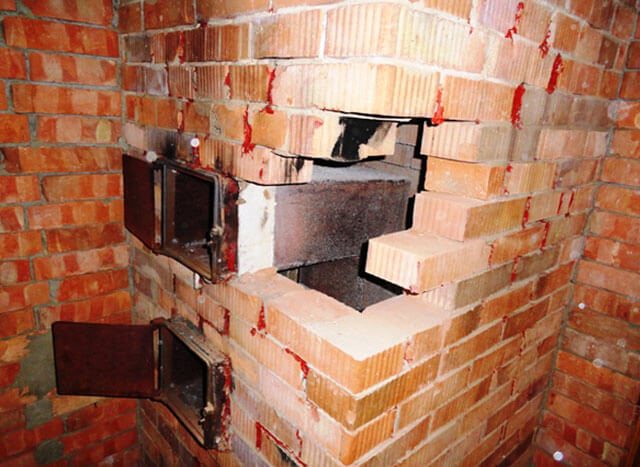

Often, during the operation of a brick oven, the cast iron plate is damaged. Today their quality leaves much to be desired, and with the constant alternation of heating and cooling, the material, unable to withstand, bursts into two or even more pieces.
The same can happen due to improper installation of the stove.
But it is also possible that the stove can still be used in the country or in the house, but due to damage to the bricks on which it was laid, it lost the necessary support, gaps appeared between the brick and the stove.
In the first case, you need to replace the stove with a new one. But we must bear in mind that the plates may vary in size. When purchasing a new stove, do not forget to accurately measure the dimensions of the old one. The new slab should be the same size as the old one, at least 10-15 mm more, but in no case less. Otherwise, instead of a banal replacement of the stove, you will have to redo the entire firebox.
Advice
In the second case, there is no need to purchase a new slab, but you will have to replace the damaged bricks of the upper row, and even more reliable - replace the entire upper row of bricks.
Decorating the stove with decorative masonry.
You can use a carpenter's ax to remove the old slab. The blade of the ax is pushed from the side under the slab and, using the handle of the ax as a lever, it is lifted. Then do the same on the other side of the plate. The stove can then be easily removed.
The way to replace damaged bricks was mentioned above. The re-laying of the upper row is carried out according to the same principle: first, the old bricks are carefully removed.
Here, the technology is simple: a thin but wide blade of a chisel or chisel is driven under the brick (a knife with a wide blade is also possible), pull by the handle and tear the brick from its place, after which it is easy to pull it out.
The surface of the bricks of the lower row is thoroughly cleaned of clay mortar and soot, thoroughly moistened with water and a new row of bricks is placed on top, observing, of course, their dressing. When installing the stove, it must be remembered that cast iron tends to expand when heated, therefore, it is impossible to firmly fix the stove in any case.
It is easier if the new slab is put in place of the old one and corresponds to it in size. In this case, the place where the stove will be placed is cleaned of the remnants of clay mortar and soot, the stove is installed and the cracks are sealed with a freshly prepared mortar.
If the slab is placed on new bricks, then you must first make a recess in them along the perimeter of the slab, and the dimensions of the recess on each side should be 5-7 mm larger than the dimensions of the slab; install a stove in the grooves and seal up with freshly prepared mortar.
note
With constant operation of stoves, a problem often arises with the firebox doors. This is typical for private houses, but such an embarrassment can also happen with a stove in the country.
What should you pay attention to?
When reworking the furnace, it is imperative to perform the following preparatory steps:
- Checking, assessing the state of the structure of the furnace and chimney. This is done without fail, since further safety of use depends on the quality. There should be good passability at the chimney, since the fireplace simply will not work without draft. The section must be at least the size of one brick. Otherwise, the thrust will be very small, completely insufficient. Usually, the chimney is immediately dismantled, after which a new one is installed in its place.
- The stove has a small firebox; this is not enough for a fireplace. This means that during the reconstruction, the size of the firebox must be increased to the required size. You can install a glass door that will cover the firebox, ensuring the safety of the structure. But this door is not obligatory, it is not necessary to specially mount it.
- It is required to carefully inspect the body of the structure. If it is intact, there are no cracks, traces of deformation, numerous falling bricks on it, then there is no need to disassemble it. It is better to decorate the surface of the case after all the work, making it more attractive.
Converting a stove into a fireplace is not required so often, usually such work is planned when there is already a stove in the house, but it is used extremely rarely. Having spent not so much time and money, you can make a beautiful and stylish fireplace from such a stove, which will not only heat the house, but also become a real decoration for any interior. Stoves are not so difficult to convert into decorative structures.
Fireplace device diagram.
Often such stoves are located in kitchens, in central rooms, they do not take up much space, but their appearance is not always aesthetically pleasing. Therefore, you can safely take on the alteration and use the fireplace as an additional source for heating the room.
To transform the stove into a comfortable and beautiful fireplace, you need to prepare the following tools and materials:
- stove brick and refractory, its volume depends on how much the stove will have to be redone;
- building level;
- Bulgarian;
- cement;
- clay masonry mortar;
- chimney ready-made pipe (if the old one has to be completely removed);
- Master OK;
- putty knife;
- cladding tiles;
- glass door for the fireplace.
Before you start converting the stove into a fireplace, it is necessary to take into account that the fireplace is heated differently. Only special wood briquettes or dry firewood are suitable. Therefore, it is recommended to immediately take care that there is always a certain amount of fuel.
All the specified materials and tools should be prepared, an individual drawing of the future fireplace should be drawn up.Its appearance depends on the original furnace. It is imperative to inspect the furnace, find out how well the body is made, in what condition the foundation is. If everything is in order, then you should not disassemble the already standing structure, the work is carried out on the material that is. There should be a gap of 25 cm between the common foundation of the floor of the house and the base for the stove, it is completely covered with sand.
At the firebox, the depth should be 50 cm, the body inside the furnace must be lined with refractory bricks.
If all the conditions meet the required ones, then it is necessary to proceed to the inspection of the chimney, as it may have to be rebuilt. For fireplaces, the requirements for chimneys differ from those for stoves, the height should be from 7 m, the cross section should be at least 13 * 25 cm. It is necessary to have special channels that will control the air flows along the doors inside the structure. This will prevent soot from constantly settling on the door glass. A variant of the converted furnace structure can be seen in the figure. IMAGE 1.
If all the necessary conditions are met, the transition to the inspection of the existing chimney is carried out, because it will almost certainly need to be rebuilt. The requirements for chimneys for stoves and fireplaces are somewhat different: the chimney of a fireplace needs seven meters in height, a cross-section of at least 13 * 25 centimeters.
Before you convert the fireplace yourself into a stove, you should carry out certain preparatory work, namely:
- Check and assess the physical condition of the old heating structure and its chimney. This must be done without fail, since such procedures will guarantee the full and safe use of the fireplace. The chimney must have good cross-section and one brick size.
- An old stove usually has a very small firebox that is not suitable for logs. This means that you will have to expand this part of the future fireplace, and then make a forged, lattice or glass door for it, which will prevent heat loss.
- If there are no cracks, defects or destruction on the stove body, it is not necessary to shift it. Upon completion of all work, it is simply covered with a new layer of plaster or decorative material.
The scheme of the fireplace stove.
Chimney diagram.
If all the conditions meet the required ones, then it is necessary to proceed to the inspection of the chimney, as it may have to be rebuilt. For fireplaces, the requirements for chimneys differ from those for stoves, the height should be from 7 m, the cross section should be at least 13 * 25 cm. It is necessary to have special channels that will control the air flows along the doors inside the structure. This will prevent soot from constantly settling on the door glass. A variant of the converted furnace structure can be seen in the figure. IMAGE 1.
Where can you see the Russian stove
We answer all your questions step by step. A huge part of the population lives in our country far from civilization. In the 90s, there was a tendency for the extinction of villages. Young people left their parental homes and went to the city in search of a better life. Many buildings were simply abandoned.
Most of the village houses were equipped with stove heating. In order to dismantle the stove, it is necessary to redecorate the flooring and seal the hole in the roof for the chimney. Not everyone had the desire and opportunity for this, so there are still symbols of warmth in the house and comfort, sung in Russian fairy tales.
Gasification made it possible to install a burner in the stove and give the structure a second life. But the modern approach to renovation implies that it will be converted into a functional, stylish fireplace.
Dismantling stove heating in a private house
The article describes the process of dismantling a stove heating in a private house. I will share my observations about why gas heating is better than stove heating, and why it was decided to dismantle stove heating.After reading the article, everyone will be able to decide for themselves whether they need stove heating, if any, gas heating. If the choice is in favor of dismantling the stove heating, then the knowledge gained from the article will help to do the dismantling yourself.


In Soviet times, most of the houses were on stove heating. Now the situation has changed and many have switched to gas or steam heating. Therefore, there is a choice - whether to leave the stove heating in the house, when switching to an alternative gas heating? In my case, there was no choice, as such, because the house was uninhabited for a couple of years, which affected the furnace heating system. The construction fell into disrepair from dampness and cold. An attempt to light the stove ended in puffs of smoke in the house. Smoke came from every crevice, even from under the floor. It was impossible to enter the house for a couple of days, everything was saturated with smoke. The house was not famous for the successful embodiment of stove heating before, and over time it completely fell into disrepair. At first there was an idea to make a fireplace with heating, but in the end it was decided to install gas heating in the house, so dismantling the stove heating was on the agenda.


In my house, I do almost everything with my own hands. Armed with a pair of gloves, a change of clothing, a crowbar, a shovel, an ax and other equipment, I got to work. First I took apart the stove itself. To do this, I removed all the metal structures. If they are in good condition, then they can be sold. If in a deplorable state, then send it for scrap. My second option.


Then, brick by brick, from top to bottom, I took apart the stove. Brick has a specific smell, therefore, when dismantling the stove, it is better to open all windows for full ventilation. The brick should be immediately taken out into the yard so as not to clutter up the space.


We had a home-made stove with a stove bench, which my grandfather made… I took everything apart from the top row to the bottom row. There is more space in the room, and less unnecessary structures. He took out building material into the yard.


The next step was the analysis of the wall with the oven heating moves. With the help of a crowbar and an ax, I completely dismantled the wall, where there is a stove heating stroke. Moving from top to bottom, disassembling one row, passed to the second. The brick was taken out into the yard.


In the future, the brick will not be suitable for construction work in a residential area and even for yard buildings, it is all soaked in smoke. But in my case, the application was found for it - from it I subsequently made a sewer pit under the ground. Therefore, the smell of brick did not become a hindrance.


I did not dismantle the pipe that goes to the roof. It does not play any role for the house, there is no smell from it. Therefore, I decided not to complicate my life and leave it. If desired, the chimney can then be used and the fireplace can be folded for beauty and comfort in the house.


When all the stove heating structures were dismantled, the house became one large room. Convenient but not practical. It is necessary to build interior partitions. There are many options for partitions: from reliable brick walls to plywood or drywall walls. I chose reliability, therefore, in my case, the walls will be made of bricks. In order to save money, I bought a used brick, not a new one. But for partitions, it will do.


In the future, it was decided to redevelop one of the partitions of the rooms, in the direction of increasing one of them. Therefore, the foundation for the partition was laid along the outer edge of the former couch, and carried out to a depth of 50 centimeters, with the usual fight of bricks and reinforcement.


I connected the 10 centimeters reinforcement to the main foundation of the house, using holes made with a puncher. All other places, under the dismantled furnace structure, were filled with a screed, to the level of the existing floor in the rooms, using lighthouses. The surface is leveled and left to dry. In the summertime, it took about three days. The resulting hole in the ceiling (chimney) was hermetically sealed with a metal sheet of the required diameter. I took it from the decorative facing of the stove.This sheet should be slightly larger than the chimney diameter. Along the perimeter of the protruding parts of the sheet, from the chimney at a distance of five centimeters, into the holes made in advance, he screwed 100 mm self-tapping screws.
To prevent moisture from entering the house and the formation of drafts, the chimney on the roof was sealed with old concrete tiles of the required diameter.


Then it's time to lay out the interior partitions made of bricks. There are many video tutorials on the Internet how to do this. I turned to an expert in this matter - to my father-in-law. In a couple of days, he laid out the partitions. Finished partitions must dry before plastering. It took less than three days.


Then you can start plastering the walls. This is not an easy task and it is better to entrust it to professionals so that the wall is even. I have an aunt in my neighborhood who makes a living by doing this. In one day, she did her job, and the walls were plastered. The plaster dries faster, after a couple of days it was possible to prime the surface and glue the wallpaper.


Now the walls look smooth, beautiful and odorless, as they did with stove heating. Gas heating does not cause any inconvenience, but on the contrary makes life better. As with the heating season, I started the system, so at the end I turned it off. I only regulate the temperature regime. It is not even worth comparing with stove heating. There are no foreign smells in the house. Walls with wallpaper look great even after five years. Therefore, the decision to dismantle the stove heating was successful and reasonable.


Options for converting the stove into a fireplace
Already passing several rows will give a complete picture of the smoke channel arrangement. At this stage, you will have to determine whether you will leave the chimney in the same form or build a fireplace option, which is a regular vertical channel.
Having compared the diagram of a real device with the most suitable fireplace project, decide which part of the masonry will remain intact. Evaluate the possibilities of modifying the rows and then proceed to cleaning all the cavities of the body. It is much easier to clean the disassembled oven than in the current one.
Each brick should be cleaned of old mortar and soot. If necessary, you can use water. These bricks are most likely unsuitable for laying the outer layers, as modern materials are more aesthetic and attractive. But when installing the chimney, they will be irreplaceable.
In the case when it is impossible to delve into the circuit and after partial disassembly the picture is not clear, you will have to continue to disassemble the oven. If there is a lot of damage in the masonry, then repairing them can be more time consuming and expensive than building a new fireplace. This idea forms the basis of the second method, how to convert a stove into a fireplace.
When disassembling the stove, do not regret the design. With a lot of cracks, it would cause a lot of problems. The very existence of the foundation and foundation is a huge legacy left by the fireplace stove. Having carefully examined the state of the base, you can carry out installation work on it. But verification is not only about integrity control. With the help of a level, you need to make sure that the plane is horizontal.
We offer you to familiarize yourself with Heliotrope - planting and care, photo
The remaining foundation indicates the boundaries of the fireplace complex. With such dimensions, it will be possible to build not just a decorative element, but a real functional fireplace with a hob for cooking. In addition to the fact that the firebox will need to be performed according to the dimensions calculated according to the parameters of the room, immediately orient yourself with the location of the chimney so that it goes as close as possible to the existing hole in the roof of the house.
A fireplace made from a stove with its full or partial disassembly can radically change the style of the layout of the room. In some cases, the oven undergoes minimal changes.They mainly relate to the size of the firebox. Then it makes sense to preserve it in its original form, decorating it with folk art painting. Naturally, modern materials are used for this, which do not leave traces and retain their appearance after long-term use.
It should be noted that with the help of such solutions, two important tasks can be solved: to equip a fireplace and to preserve the memory of Russian craftsmen in the house. After all, the Russian stove differs from the designs of other countries by the presence of a stove bench. This stove bench can be left for decoration, or it can be turned into a working fireplace unit.
It is important to assess the state of the furnace itself and the foundation. If all is well, then you can proceed to the next stage.
The simplest modification option would be to convert the stove into a decorative fireplace. It doesn't take much time and effort.
The necessary materials and tools will be:
- new chimney;
- bricks;
- mortar for masonry;
- putty knife;
- Master OK;
- several bags of cement;
- a sufficient amount of clay;
- level;
- finishing material (for example, tiles);
- glass door optional.
When converting, it is necessary to comply with the conditions for the fireplace.
It is important to check the chimney pipe:
- its height should be at least 7 m (more is better);
- section - more than 13x25 cm;
- the depth of the firebox should be about 50 cm, but not less.
When all the stages are completed, then the finishing stage begins. Here, of course, everything is individual. The choice of materials depends on the personal tastes and preferences of the owners, as well as on the style of the interior. The main materials that are used for decoration: stone, tiles, tiles. Undoubtedly, a stone-trimmed fireplace will look very impressive and chic.
We offer the simplest advice on how to convert a stove into a fireplace. It consists in expanding the firebox of the old design, after which it is covered with a decorative door made of tempered glass or other material. In this case, there is no need to change the outdated structure, although the stove itself will still have to be thoroughly cleaned. It is recommended to make decorative wall covering in the form of tiles, tiles or artificial stone.
Complete disassembly of the stove and the subsequent construction of the fireplace is the most expensive and time consuming option. The original structure is completely dismantled, the base is inspected and sand is added. In place of the future fireplace, waterproofing in the form of roofing felt is laid, after which a new heating element can be assembled.
In this situation, the following sequence of actions should be performed:
- Dismantle the old stove, inspect the base and repair any possible damage on it.
- To protect the base from the high combustion temperature, you need to fold the podium out of bricks.
- According to the previously prepared scheme, lay the fireplace, for which a specific stove brick with refractory capabilities is used. It is recommended to make the firebox as wide as possible, which will not only create an excellent decorative effect, but also make the use of the finished structure extremely safe. It is recommended to lay the floor and walls around the fireplace with non-combustible material in the form of tiled tiles, real or artificial stone.
How to disassemble the stove with your own hands
First of all, you need to inspect the product and the ceiling near the chimney. The pipe can be made of iron or brick. The necessary dismantling actions will depend on the characteristics of the furnace arrangement.
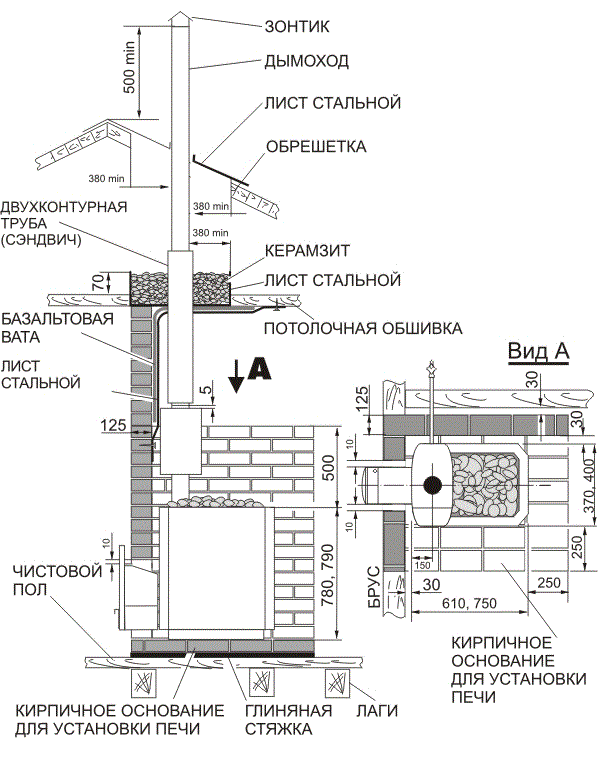

Dismantling an old furnace is much easier than folding a new one, but knowledge of the furnace equipment design is required
Previously, the Russian stove was often used to fix the load-bearing parts of the ceiling. The stove can be disassembled only when it becomes clear that there is no support for the chimney device, and the ceiling and roof will not collapse.When completely dismantling a Russian stove, first of all, you need to find out if its body is supported by some important element. First you need to disassemble the floor base around the stove and inspect the foundation.
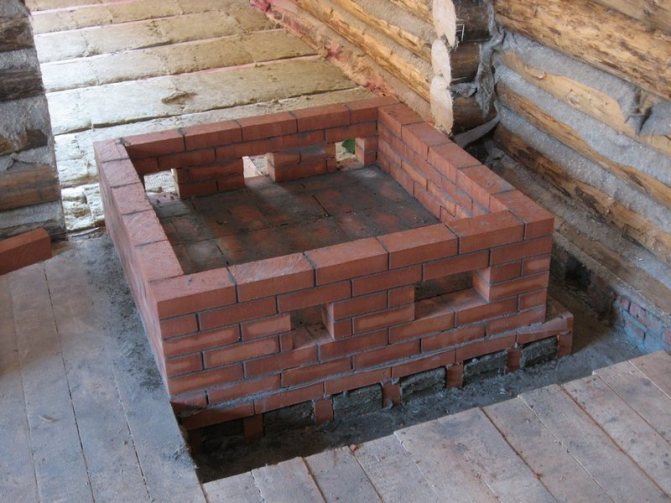

If the furnace has a separate foundation, then it is better to dismantle it too.
In some cases, it is possible to remove the lower part from the support and dismantle it without damage, without the need to disassemble the structure. However, in this case, additional labor will not be superfluous, since the work is difficult.
It is important to prepare the room in advance for disassembling the stove. Furniture and decorative ornaments should be covered with foil, as the soot accumulated on the inner base of the stove will be difficult to remove from the surface.
To disassemble the oven, you should prepare the following tools:
- sledgehammer;
- pick;
- respirator;
- scrap;
- gloves;
- steel wedges;
- puncher;
- chisel.
The structure is disassembled from top to bottom. First, you need to disassemble the roof section near the chimney, after which you can start dismantling the brick. The metal chimney is dismantled by loosening it from side to side. A brick pipe is disassembled sequentially. You need to start with the chimney, and then go into the house. If the masonry was made using a solution of sand and clay, then a hammer and a chisel will be needed from the tools. It is most convenient to disassemble the masonry in horizontal rows in a circle.


The chimney is disassembled starting from the outside
Difficulties can arise when disassembling a stove, the bricks of which were laid on a cement mortar. In this case, a punch is needed. If used correctly, time costs can be reduced. The punch blade should be guided along the seam between the bricks. To save the material for reuse, you need to try to avoid significant chips.
With the help of a crowbar, it is rather difficult to accurately disassemble the masonry horizontally. Scrap blows can damage a large number of bricks, as it is difficult to hit exactly at the seam.
To disassemble brickwork that has been laid on a strong cement mortar, wedges made of steel or plastic are used.
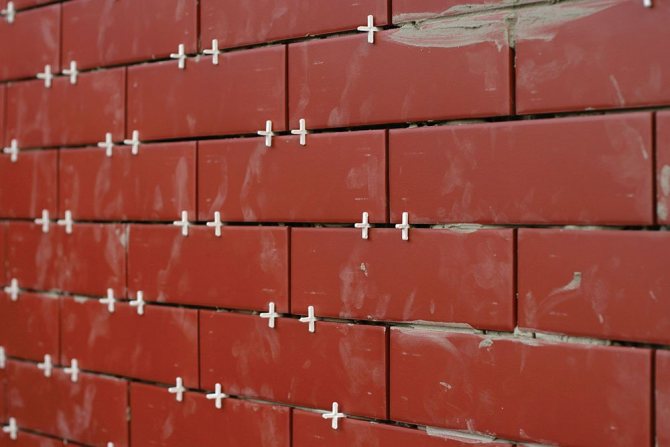

Wedges are driven into the seams of the masonry
Sequencing:
- In several places in the extreme part of the masonry, drive the blades into the seams horizontally.
- If the masonry is strong, then the blades will need to be hammered into the seams along the vertical.
- Disassemble the masonry using a punch or a crowbar. If work is carried out in the attic, then the sledgehammer should be handled carefully so as not to damage the walls and beams.
- The bricks must be separated and dismantled in rows from top to bottom.
- Lay the recesses in the ceiling with bricks.
- When the chimney is disassembled, carry out the work gradually in a circle.
- Remove the hob, doors and grate when empty.
It is recommended to hammer the wedges with an assistant. One person should place the blade in the holder and direct it into the masonry seam, and the other, using a sledgehammer, will drive the blade into the seam between the stones.
The final stage is the disassembly of the bottom and base of the stove.
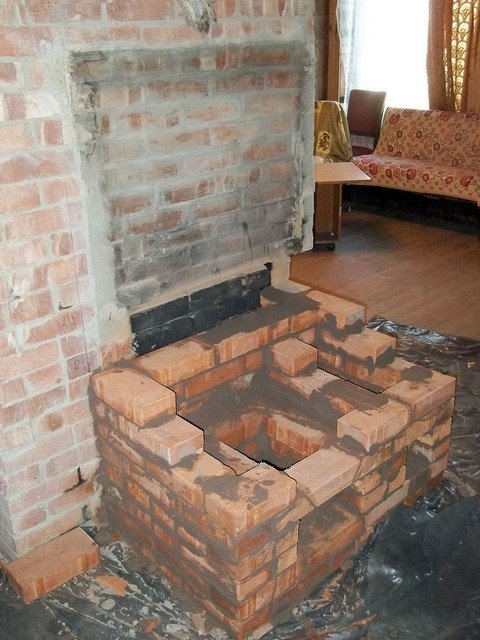

Disassembly of the bottom of the stove is done last.
If the structure is made in such a way that the foundation can be removed from the supporting parts and taken out, then this must be used. You will need helpers to get the job done. If the base of the stove is still needed, for example, to build a fireplace, then you do not need to dismantle it. The holes in the floor must be patched with wooden planks.
Video: the process of dismantling the stove
What will the reconstruction of the furnace give
The Russian stove in the house is installed in such a way as to warm up the maximum living area, and the location in the center was not excluded. Now think, isn't this modern style?
In our view, the stove bears the image of a certain structure with uneven edges and whitewash that leaves marks on clothes in the event of an accidental touch, and if you align the edges and use modern materials, then interesting projects appear offhand, which, according to the originality of the idea, will not yield to leading design developments.
The possibility of building island types, wall options, stylizing the room for the decoration of a peasant hut (a promising direction). All this awaits us after converting the old stove into a modern fireplace.
How the stove differs from the fireplace
Now let's dive into the realities of the upcoming work and note their laboriousness and complexity of implementation in technical and theoretical terms. To understand how to make a fireplace from a stove, it is necessary to determine all types of work required. Only a real pro can do this, so attracting a master will most likely become a prerequisite. But for the sake of information, we will explain how to conduct a reconstruction analysis.
The stove is no different from the fireplace. Both devices work by burning fuel and both are involved in heating the room. Still, one of them is called a stove, and the other is called a fireplace.
- The functions of the furnace are not designed to provide an opportunity to observe the flame, therefore, all technological nuances are aimed at high-quality and efficient use of heat. The firebox door is made of metal and hides the combustion process from the eyes of the observer.
- The gases produced after combustion are at a high temperature. I don't really want to give such energy to nature, so the chimney in the furnace body is made in the form of a labyrinth. When moving, heated gases give up their heat to the bricks of the stove.
- The firebox of the Russian stove is slightly smaller than, according to calculations, should be near the fireplace for such a room.
Otherwise, the differences concern only external elements, which can be used in the converted structure.
How to decorate a fireplace?
It is not so difficult to make a fireplace out of a stove, if the structure is strong and reliable, then you can only expand the hole for the firebox, make a beautiful and convenient portal out of it. After that, you can mount a glass fireplace door, which will add integrity and decorativeness to the entire structure. Finishing work is carried out last, for this we can use any material with which fireplaces are faced.
The question of how to make a fireplace out of a stove arises among many summer residents. There may be several options for such alteration, the work itself must be started with a careful examination of the stove, it is quite possible that you will not have to do the masonry from scratch. This will significantly save your budget and time.
- Choosing a heating boiler for a private house
- Furnace heating design
- Technologies for insulating the floor of the first floor in a wooden house
It is not so difficult to make a fireplace out of a stove, if the structure is strong and reliable, then you can only expand the hole for the firebox, make a beautiful and convenient portal out of it. After that, you can mount a glass fireplace door, which will add integrity and decorativeness to the entire structure. Finishing work is carried out last, for this we can use any material with which fireplaces are faced.
When and why is it necessary to repair the stove
Most often, stove repair is required when traction suddenly deteriorates. The following signs may also indicate the need for repair:
- the formation of cracks in the masonry;
- puffing up the oven;
- loosening of the furnace door;
- burnout of the grate;
- cracking of seams in masonry;
- poor combustion of fuel;
- leak at the junction of the roof with the chimney;
- damage to stove appliances.
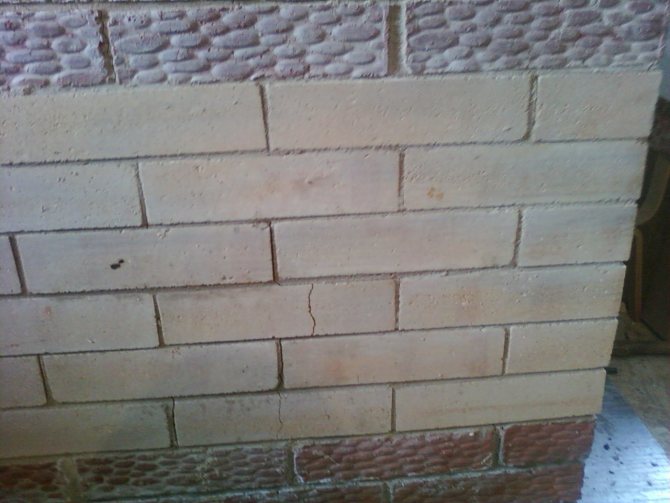

Cracking of the kiln masonry is a sign of the need for repair.
It is worth remembering that a stove is not just a technical structure in a private house. The design must comply with sanitary standards and fire safety requirements. If you do not pay enough attention to the maintenance of the stove, then a fire hazard or carbon monoxide poisoning of the residents of the house may occur.
Stove repair is essential for human health and property. If you need it, then don't put it off. Special attention should be paid to maintenance before the start of the heating season. In the absence of experience in carrying out repair work on furnaces, it is recommended to entrust this task to a qualified specialist.
In some cases, the cost of repair work can make it impractical to carry out them, so it is important to determine the breakdown first.
Possible reconstruction options
There are several options for converting old stoves (Russian stove, "potbelly stove") into a fireplace, they all depend on the initial technical condition of the structure.
One of the easiest options is to update and expand the firebox to the required size, as well as install a glass "Finnish" door. This option is attractive for its simplicity, since there is no need to make drastic changes to the design, it is enough just to properly clean the oven. If you add a glass door and properly decorate the existing stove, it will be as similar as possible to a fireplace.
The most expensive and time-consuming modification of a stove into a fireplace is a complete disassembly of the existing structure and the creation of a new one. The stove must be completely dismantled, if necessary, pour new sand into the base. Next, make a roofing roofing waterproofing flooring and create a new masonry according to one of the existing schemes.
Fireplace decoration: choosing the right material
Converting a stove into a decorative fireplace is not very difficult. This is mainly required in cases where an ordinary stove is already installed in the house, which is no longer used. It will not take a lot of effort and money to create a modern stylish fireplace from an ordinary stove that can heat the house, and in addition, bring comfort to it.
Often, old stoves are located in houses in the kitchen or in the central room. The stove takes up little space, but the appearance leaves much to be desired.
We offer you to familiarize yourself with Ideas for giving with your own hands - Vegetable garden, garden, balcony
To convert the stove into a modern and stylish fireplace, you will need the following materials: bricks, cement, masonry mortar, chimney (to replace the old one), facing tiles, a glass door, as well as tools for minor repairs that every owner will certainly have. ... Next, you need to draw up a personal drawing of the fireplace to be created.
Another important requirement is that there should be a small gap between the base for the stove and the foundation of the house - about twenty-five centimeters, it must be completely covered with sand.
After these conditions are met, you can proceed to checking the chimney pipe. The requirements for its height are more than seven meters, and the cross section is more than 13 by 25 centimeters. And the last step is to provide for the presence of channels that can direct air flows along the doors, which will not allow soot to settle on the glass door all the time.
Particular attention should be paid to the appearance of the former stove. If you keep the old case, it may not look aesthetically pleasing enough in the interior of the room. This can be corrected with the help of competent finishing.
The time taken to finish the fireplace depends on the complexity of the decor.
Old masonry can be rendered beautifully if it is handled well. Using an abrasive material, you need to remove excess mortar from the seams. You can also update the seams by making them bulging. Another interesting decor option is to renew the seams with a solution with a colored pigment.
Brick trim can be painted with heat resistant paint
The brick itself can be painted with heat-resistant paint. If it is preserved in excellent condition, it will be enough to cover the brickwork with a paint and varnish composition that is resistant to high temperatures.
This method of finishing work can be considered one of the simplest and most affordable. Plaster does not require installation, such as stone or tiles.
The plaster mixture for the fireplace must be sufficiently strong. To do this, add salt and finely chopped fiberglass to the plaster. To add color you can add lime-based paint.
Before starting work, it is advisable to heat the fireplace, since the surface should be slightly warm. You also need to moisten the surface.The plaster is applied in several layers. The first layer must be applied with a trowel and the walls of the fireplace must be leveled. When it is dry, you can start applying the second coat. Its thickness should not exceed half a centimeter.
The layer is applied with a trowel or brush and smoothed in a circular motion. To apply the plaster with a wave effect, use a sponge or rubber trowel to apply the second layer.
Various types of natural stone are used to decorate fireplaces. The most difficult thing to work with is granite or marble, as it is a fairly durable material that cannot be processed without special tools. You can decorate the fireplace with such stones as limestone, shell rock, as well as rubble stone.
A cheaper finish is the use of artificial stone. You can purchase it or make it yourself. To do this, you should prepare in advance silicone molds that imitate real stone blocks. A mixture for artificial stone consists of cement, sand and paint of the desired shade.
A fireplace portal can become a real work of art if you apply curly stone carvings
Particular attention should be paid to the fireplace portal. Uneven stones can be stacked together to simulate a furnace from the days of knightly battles. A fireplace made of marble blocks will add luxury to the furnishings. You can build stone columns or use natural stone in several colors.
Another common finishing material for stoves and fireplaces is tile.
Several types of material are used:
- clinker tiles;
- porcelain stoneware;
- majolica;
- terracotta.
Before tiling the fireplace, remove the coating left over from the stove. You can leave it only if you first pull the metal mesh over the fireplace and fix it with self-tapping screws. The base of the fireplace is leveled with glue. When the mixture is dry, you can fix the tiles.
You can use a fireplace converted from a stove two weeks after finishing. Heat the hearth with only dry logs. During the first kindling, you need to check the operation of the chimney, assessing whether there is an unpleasant odor in the room. Smoke can go into the room due to too strong or weak draft in the chimney, as well as due to errors in calculations.
Natural or decorated stone, which gives sophistication and presentability to the appearance of the fireplace, is an excellent solution for such purposes. Ordinary heat-resistant brick is also quite popular - it would seem that it is a completely unpretentious material. In addition, the variety of ceramic tiles on the modern market can correspond, perhaps, to all kinds of decorating solutions that came to mind of the owners of the apartment. If you don't want to deal with decor and cladding, you can contact the knowledgeable masters of their craft.
“I changed the Russian stove to the Finnish one - and I didn’t regret it!”. The story of a son who gave his parents warmth in the house
This house does not stand out in any way against the background of dozens of the same ones that make up the basis of the Belarusian village of Tishkovshchina. The old, slightly rickety wooden building does not hide its age: three generations of the Tishkevich family lived in it. And only new plastic windows and fresh paint indicate that people who take care of their homes live here. A small dressing room meets the atmosphere of a country house: the aromas of mature wood are mixed with the cozy scent of home textiles and apples. And when the front door opens, we are enveloped in a wave of warmth and light ...


The source of heat is unmistakably identified: at one of the walls of the spacious kitchen there is an outlandish stove resembling a fireplace, inside which a flame is raging. This is the pride of the Tishkevichs' house, practically a new member of the family, who recently replaced the bulky (and, alas, problematic) Russian stove. The hostess of the house, Stephanida Semyonovna, is busy at the stove, placing a cast-iron pot with rabbit meat on the cooking surface.Putting it down, puts down the pot holder, smiles and invites you to come in. In a minute, her son Sergei will join us. It was he who made a “warm” gift to his parents.


There is no gas in the village. All their life Stefanida Semyonovna and her family heated the house with a Russian stove. There was no shortage of firewood: there was a forest nearby. The parents of Stephanida Semyonovna, who built the house, once went to the forest themselves for firewood, today they bring fuel by order, from the nearest agricultural enterprise, on a tractor with a trailer. The Tishkevich family buys firewood no more than once a year - so as not to drive the equipment for nothing. But they take a lot, the last time - 12 cubic meters, this was enough for almost two heating seasons.
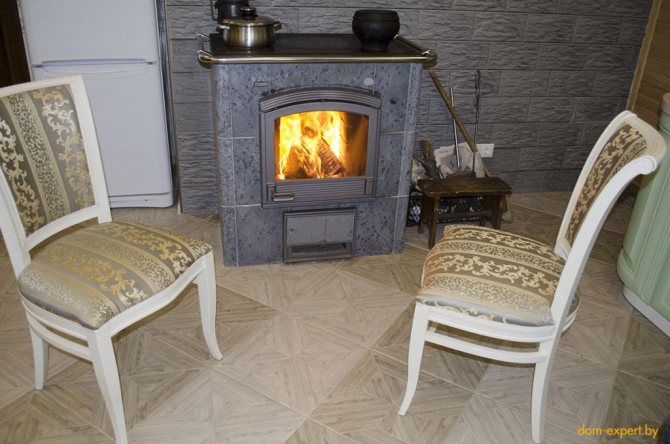

- The Russian stove must be heated at least twice a day. And she consumes a lot of firewood, 50 kilograms a day, or even more,
- says Stephanida Semyonovna. -
We were worn out with the stove: it gave off a smell of smoke, it cracked regularly. You paint it - it smells of paint for a long time, it hurts your head. They covered it with tiles - so it began to crack, fly off. And to clean the chimney from soot is still an "adventure". You climb onto the roof with a broomstick, tie it to a stick, and you work as a chimney sweep. And where you can't reach - there you had to resort to the old-fashioned methods: they dried the husks from the potatoes and burned them, with this smoke the chimney itself was cleaned. I have been living here for a long time, and all these years they have been cleaning like this. This is now all sorts of powders invented, before this was not.
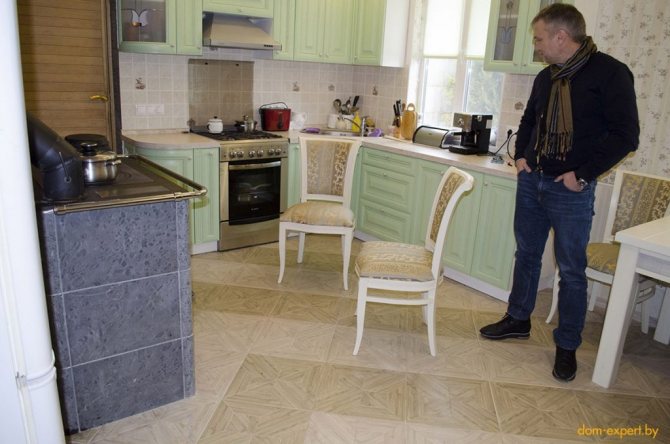

- It is too early to judge about soot, but taking into account the ceramic chimney, we assume that we will not clean the new stove more often than once a year, -
Sergey enters the conversation
... - Soot hardly sticks to ceramics. And in general, a new stove for maintenance is a gift: once every two days, remove the ashes from the lower compartment, and that's all. However, these are just pleasant "bonuses" for operation. The reasons why we wanted to change the oven are different.
Firstly, the size of the Russian stove was 4 times larger than the current one. One of the reasons for the replacement was precisely the dimensions - I wanted to increase the kitchen space.
Secondly, we are tired of repairing it every year. Maybe it's age (the stove was old), but the fact remains.
And the most important thing: you do not need to run often for firewood. Mom is 72 years old, father is 74. Going to bring 4 kilograms of firewood is one thing. And to run 3-4 times a day and carry twice as much is quite another. For an older person, the difference is palpable.
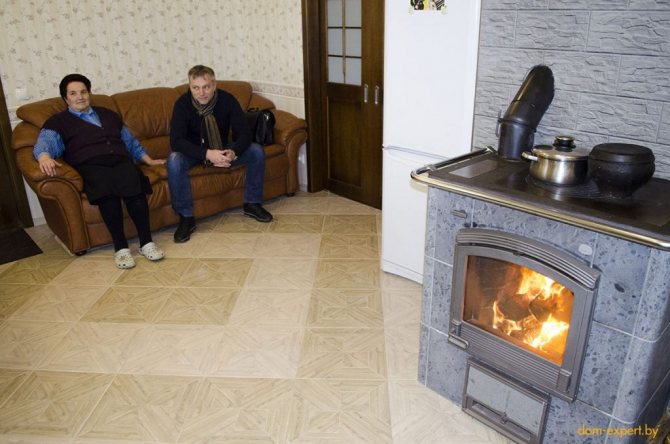

- In cold weather, the Russian stove used to consume 3 cubic meters of firewood per month, -
says Sergey
... - It's about 1500 kilograms. The new one has a consumption - 5 times less, and it gives more heat. This both felt and objectively: we measured at the same outside temperature. To heat a Finnish stove once, you need about 4 kilograms of firewood. I’ll say more: now, at temperatures near "zero", we have even reduced the oven setting to three kilograms - otherwise we have to open the window for ventilation, it gives out too much heat.
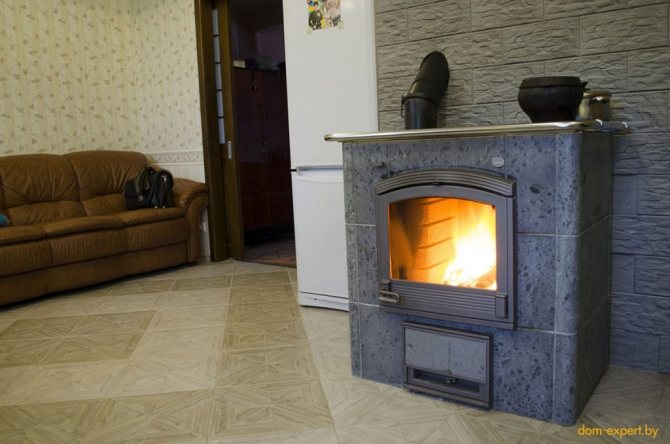

- The Finnish stove heats up for 2-3 hours, but it also keeps heat for a long time - 12 hours. Everything - thanks to the material talcomagnesite, which is considered a better heat accumulator than oven bricks. When I was going through the options, I immediately drew attention to this fact. The cheaper options were dismissed, mainly because of the material - in most cases it was metal, in one form or another. And I wanted to take a stove with a margin of strength and heat capacity, made of stone. I began to study the parameters of the materials and came up with talcomagnesite. Everywhere they wrote that the best parameters of this stone are found among the Finns, although there are deposits in other countries. When searching, it turned out that the company makes such furnaces
Tulikivi, and in Minsk only one offered its products. I went to them, watched the oven live - and realized that this was exactly what the parents needed. The furnace cost 5600 rubles, plus 14% for installation. But, looking at the happy faces of the parents, I don’t regret the purchase.
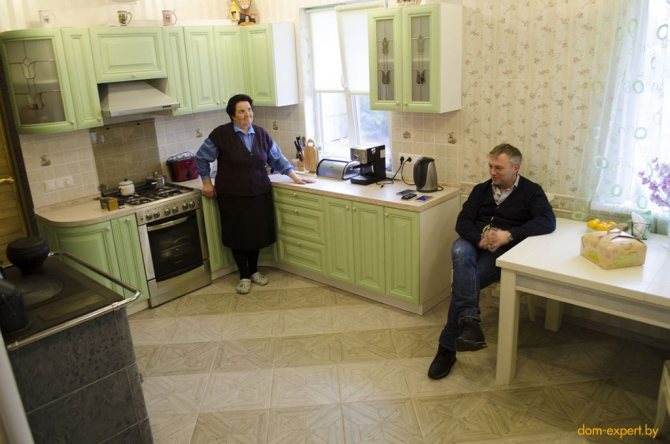

- I also liked the manufacture of this product, the reliability,
- Sergey continues.
- When you order a stove from a stove-maker, it's always a bit of a lottery: how good a specialist he is, whether he knows the necessary installation technology, what materials he will use - it is not known for sure. Here you understand that the manufacturer has tested everything in the factory, that he guarantees the exact characteristics, consumption, and durability of the product. And, frankly speaking, it bribed production in Finland. I believe that Finns do quality things. Well, I liked the model itself: this is an option with a stove, and we cook all the time.
- Everything is cooked very quickly on the new oven
, - confirms Stephanida Semyonovna
... - Faster than in Russian. For the warm season, we use a gas stove (it is brought in cylinders). And in winter - why waste gas? We heat the stove all alone, there is enough heat, even in excess. And when the wood burns out, a grate is installed inside the firebox, and food can be cooked on coals, like in an oven. So with the help of this oven you can bake, and fry, and boil - it completely replaces the stove with the oven.


- Such oven heats 60 sq.m. living space
- continues Sergey. -
We don’t have that much, so it can handle the stock. True, even before buying the stove, we insured ourselves, bought a small electric boiler, and installed a radiator in two living rooms. But now we don't even turn it on - as long as there is no severe frost, there is enough heat from the stove.
Moreover, the heat goes in both directions: we deliberately did not lay the wall behind the new stove - its back side goes into the living room and heats it too. Everything else is done by the natural movement of air - the heat "spreads" throughout the house. The chimney itself, by the way, is also lined with plates from the outside that do not heat up. Such styling is also safe from the point of view of harmful emissions: it cannot crack, it is almost impossible to get poisoned by carbon monoxide. Unlike the Russian stove, where such a probability is still present.
- Well, visually, the oven pleased
, - Sergey smiles. -
Outwardly, it looks modern, stylish, and the door, like a real fireplace, is large, the fire is clearly visible. And what a pleasure it is to wait at the stove while the rabbit is cooking, to look at the fire and feel the delicious smell of fried meat scattering along with the warmth around the house ... With such a stove, a fireplace is not needed.
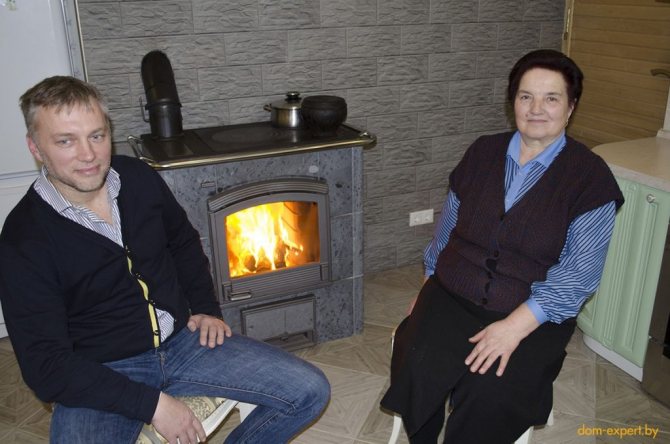

Text: Dmitry Malakhov
With the informational support of the "Warmth in the House" fireplace salon
Ask an expert
Preparatory work
Before making fireplaces with your own hands from the stove, you should measure the sources.
It is necessary to check the following parameters of the Russian stove:
- Examine the stove for chipped brickwork or other damage. Check if the solution is weak. If several bricks are deformed and may fall out, the stove will need to be completely disassembled. Note if the inside of the oven is made of refractory material.
- Estimate the dimensions of the combustion hole. Since stoves were used as a heat source or for cooking, fireboxes were often small in size. To determine which insert is right for your fireplace, measure the dimensions of the room. The firebox should occupy 1/50 of the area of the room. 2 parts of the height are 3 parts of the width. Consequently, the size of the furnace hole must be calculated so that when multiplying the width by the height, an area equal to one-fiftieth of the area of the room is obtained. The depth of the firebox must be at least 50 cm.
- The construction of a fireplace depends a lot on the foundation. The space between the foundations of the floor of the room and the stove should be about 25 cm. The gap should be filled with sand.
- The chimney should be examined carefully enough, since all further work of the fireplace depends on it. A strong draft must be generated in the chimney. The minimum permissible chimney height for a fireplace is 4.5 meters. The optimum height is 7 meters.The duct pipe should be such that a whole brick could easily be inserted into it.
If the stove has not suffered much over the years of operation, then it will be enough to expand the furnace hole and install the door
After checking the material and calculations, it is easy to determine the methods of how to make a fireplace out of the stove with your own hands. If the stove has not deformed at all over the years, it will be enough to expand the furnace hole and install a glass door. If the chimney is too narrow for the fireplace, you will need to dismantle the chimney. In the case of a weak foundation, the only way out is to completely dismantle the old stove and install a new fireplace.
Progress advice
Alternatively, you can suggest not completely disassembling the central, largest part of the stove, which was used as a stove bench. You can remove just one wall, and use the rest for niches and shelves. Much will depend on your imagination here. Perhaps you get fired up with the idea of \ u200b \ u200bbuilding a fireplace and use part of the construction of an old Russian stone stove.
The final stage is the dismantling of the furnace foundation. If the design is such that the base of the furnace can be removed from the support and taken out without disassembling completely, this should be used. We'll have to find helpers, because you can't do without outside help.
If the foundation of the stove does not interfere with your plans, then it can be left. Holes in the floor should be patched with planks. The work on dismantling the furnace ends here.
Converting the stove into a fireplace
The very first action that needs to be done before installing a new fireplace is to prepare a future drawing. All dimensions must be suitable for the old foundation.
Converting a stove into a fireplace takes place in several stages:
- The furnace foundation is reinforced with waterproofing. Roofing material is used as a waterproofing material. Several layers of material are placed on a clay-cement mortar.
- The next step is to install the base under the fireplace. You can either build a new base or install an oven base if it is in excellent condition.
- The firebox is made according to the new drawings, since the furnace firebox is not suitable for a fireplace. To create a base for the firebox around the circumference, the structure is lined with brickwork.
- The firebox itself is being built. The walls should be made vertical. It is advisable to check the clarity of the lines of the future side walls of the firebox using a building level.
- Correct calculations are also important at the chimney construction stage. It is laid out with brickwork. Each several rows need to remove excess solution from the inside of the chimney, as soot may subsequently remain on them. Because of this, the chimney will have to be cleaned frequently.
The air duct can be made not only of bricks. You can consider the option of a sandwich pipe, the streamlined shape and smooth walls of which do not impede the exit of smoke from the fireplace.

